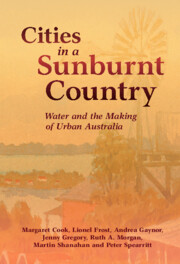Book contents
- Cities in a Sunburnt Country
- Studies in Environment and History
- Cities in a Sunburnt Country
- Copyright page
- Contents
- Figures
- Maps
- Book part
- Tables
- Acknowledgements
- 1 Prologue
- 2 Living Water
- 3 Domesticating Water
- 4 Keeping Up
- 5 Transforming Homes
- 6 Watering Suburbia
- 7 Crises of Confidence
- 8 Twenty-First Century Australian Cities
- 9 Epilogue
- References
- Index
- Studies in Environment and History
6 - Watering Suburbia
Published online by Cambridge University Press: 19 May 2022
- Cities in a Sunburnt Country
- Studies in Environment and History
- Cities in a Sunburnt Country
- Copyright page
- Contents
- Figures
- Maps
- Book part
- Tables
- Acknowledgements
- 1 Prologue
- 2 Living Water
- 3 Domesticating Water
- 4 Keeping Up
- 5 Transforming Homes
- 6 Watering Suburbia
- 7 Crises of Confidence
- 8 Twenty-First Century Australian Cities
- 9 Epilogue
- References
- Index
- Studies in Environment and History
Summary
After World War II, Australians and new migrants rushed to build their dream home and garden. As housing estates proliferated in the suburbs, local authorities struggled to keep pace with increasing demand for water supply and sewerage connection. In all five cities, suburbs were constructed with no roads, kerbing and channelling, or sewerage. New subdivisions had reticulated water, but manual night cart collection continued in some suburbs and septic tanks were common until sewer lines were built. As the housing stock increased and septic systems were replaced with reticulated sewerage, water supplies were stretched beyond capacity. Authorities turned to the well-worn path of dam construction to increase supply, but when consumption exceeded capacity, especially in hot, dry seasons, unpopular water restrictions were implemented, with hoses and sprinklers banned. The sight of green suburban lawns turning brown undermined the myth of unlimited supply at the turn of a tap, but expectations were reinstated as soon as it rained.
Keywords
- Type
- Chapter
- Information
- Cities in a Sunburnt CountryWater and the Making of Urban Australia, pp. 135 - 162Publisher: Cambridge University PressPrint publication year: 2022

